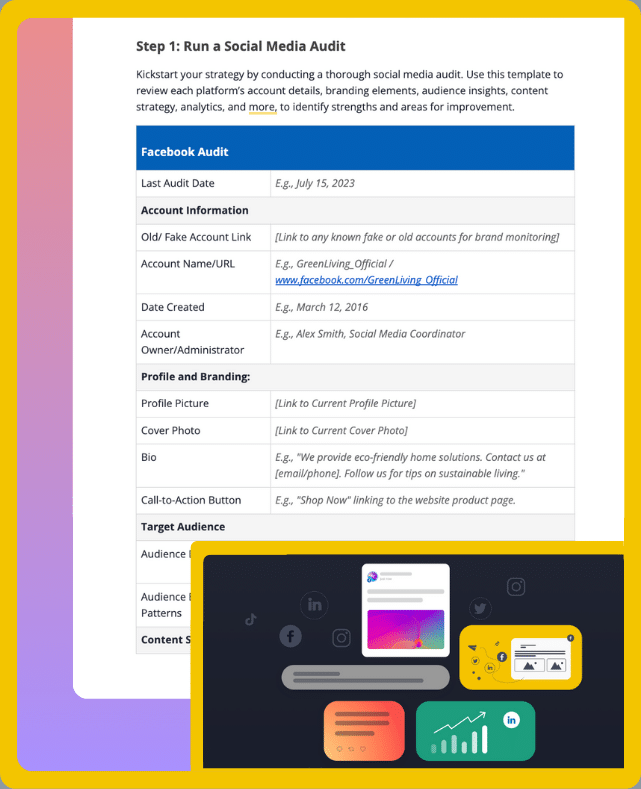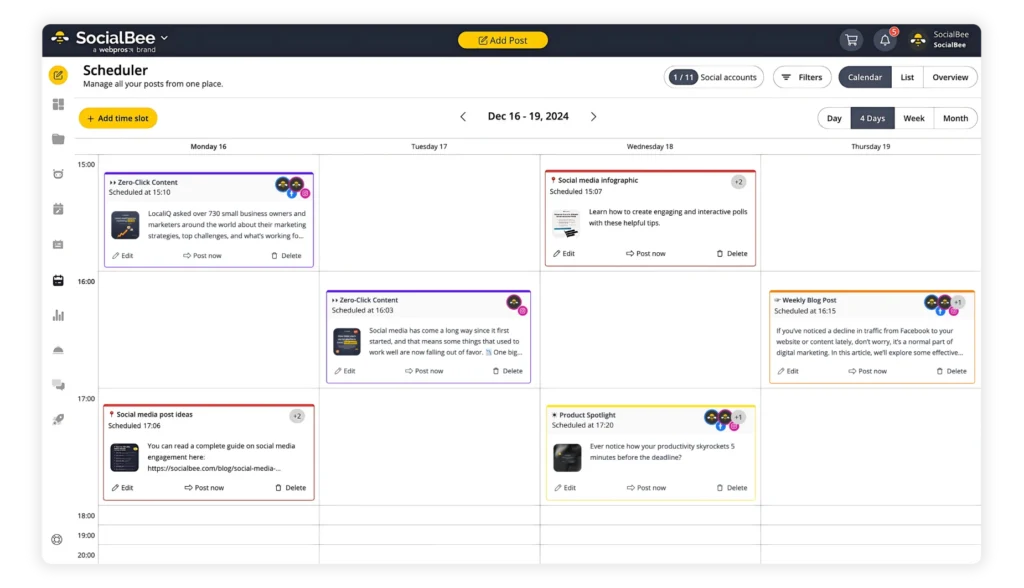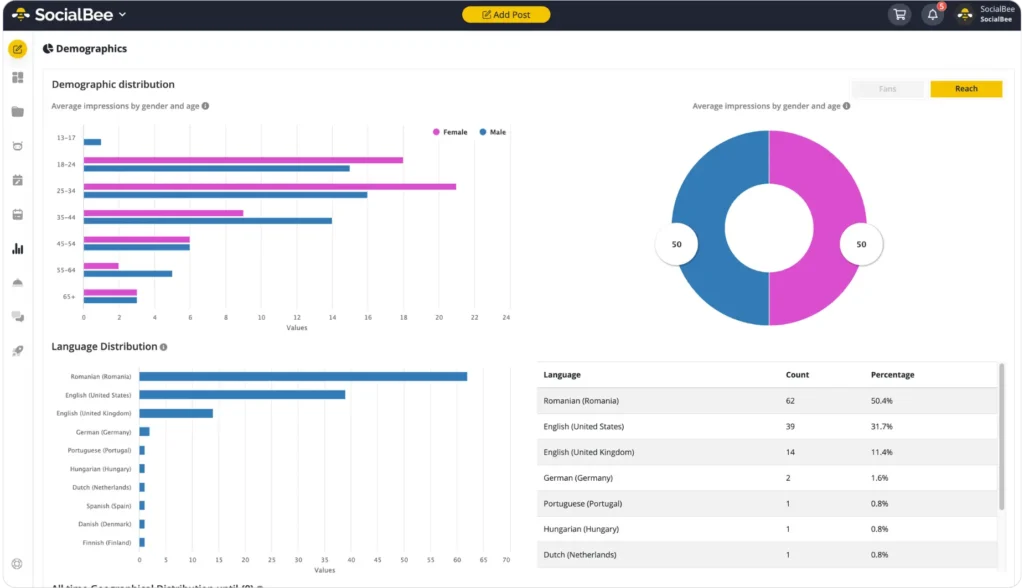
Content Writer at SocialBee
In today’s digital-first business environment, understanding the ins and outs of social media management costs is crucial.
This article aims to demystify these expenses and offer smart ways to manage your budget effectively while strengthening your online presence. We’ll break down social media management costs in simple terms, making it easy for businesses of any size to understand what they’re up against.
Stay with us to the end of this article to learn how to make every dollar work harder for your business, enhancing your growth and online visibility. Shall we begin?
We’re SocialBee LABS SRL, part of WebPros. We use the information you provide to share relevant content and product updates, as outlined in our Privacy Policy. You can opt out anytime.

Short Summary
- Social media management services encompass strategy development, content creation, scheduling, community engagement, performance analysis, advertising, and crisis management to enhance brand presence and engagement online.
- Freelance social media management can cost between $15 to $50 per hour for basic services, with specialized skills commanding higher rates.
- In-house social media management involves salaries ranging from $35,000 to over $70,000 annually, plus benefits and training costs.
- Social media agencies offer comprehensive services with monthly retainers from $1,000 to $20,000, depending on the scope of services.
- Social media management software provides cost-effective tools for scheduling and analytics, with pricing starting at approximately $30/month.
- To determine the right social media management pricing, start by clearly defining your business goals to ensure your social media efforts align with your overall strategy.
- Choose KPIs that reflect your business objectives to measure the effectiveness of your social media management efforts accurately.
- Assess your team’s capabilities to determine if there are gaps that need external support or further development.
- Allocate a portion of your sales to social media management, ensuring it’s sustainable and proportional to your revenue.
- Regularly evaluate your marketing plan and social media ROI to adjust your strategy and ensure your investment contributes positively to your business goals.
Table of Contents
- What Do Social Media Management Services Include?
- How Much Does Social Media Management Cost?
- Hidden Social Media Management Costs
- How to Decide Between Freelance, In-House, Agency, or Software Social Media Services
- How to Decide Which Social Media Management Services & Costs Are Best for You
- Frequently Asked Questions
- Excel at Social Media Management with SocialBee!
What Do Social Media Management Services Include?
Social media management services are paramount for marketers and businesses aiming to maximize their online presence without stretching their budgets too thin.
Here’s what social media management services include:
- Strategy development: Key steps include choosing the right platforms, setting clear goals, and planning content themes. This ensures that your brand’s message is cohesive and hits the mark.
- Content creation and curation: Great content is the root of social media success. It’s about mixing eye-catching images, engaging videos, and useful infographics with carefully curated content.
- Publishing and scheduling: Scheduling tools help you stay consistent and ensure your content reaches your audience when they’re most active, keeping your brand front and center.
- Engagement and community building: Engaging with your community by responding to comments and joining conversations makes your followers feel valued, deepening their connection with your brand.
- Analytics and reporting: Tracking engagement rates, follower growth, and content performance gives you insights to fine-tune your social media marketing strategy, making every post more effective than the last.
- Advertising management: Crafting targeted advertising campaigns and managing budgets wisely can boost your visibility and engagement, giving you a better ROI.
- Crisis management: Monitoring your brand and responding quickly to any negative feedback helps protect your reputation, keeping your brand’s image positive.
How Much Does Social Media Management Cost?
The costs associated with social media management can vary widely based on the range of services required, the level of expertise involved, and the size of your business.
Here is how much social media management costs:
- Freelancer social media management cost: $14 to $35 for basic services, +$100 for specialized skills, and $200-$1,000 for package deals
- In-house social media management cost: $52,000 to $82,000/year
- Social media management agency cost: $1,000 to +$20,000/month
- Software social media management cost: paid plans start at approx. $30/month
A. Freelancer Social Media Management Cost
Hiring a freelancer for social media management can be a cost-effective solution, particularly for small businesses or those with specific projects on the line. Freelancers offer a range of prices, typically influenced by their experience, the complexity of their work, and geographical location.
Here is the cost of freelancer social media management:
- On average, freelancer rates can range from $14 to $35 per hour for basic services like content creation and curation, scheduling, account optimization, engagement with followers, and basic analytics monitoring.
- For more specialized skills, such as graphic design or advanced analytics, rates can escalate to $100 per hour or more.
- Freelancers might also offer social media management package deals, which can range from $200 to $1,000 monthly, depending on the services included. However, ConciergeBee offers social content creation packages from $99/month, content marketing packages from $129/month, engaged growth packages from $129/month, and acquisition and amplification packages that start at $299/month.
B. In-House Social Media Management Cost
Building an in-house team to manage social media brings the advantage of dedicated resources fully immersed in your brand’s culture and goals. The cost here includes salaries, benefits, and ongoing training for the staff.
Here is the cost of in-house social media management:
- An entry-level social media manager’s salary can start from $52,000 annually in the US.
- More experienced managers in competitive markets might command salaries upwards of $82,000 or more.
Remember, the total cost will also depend on the size of the team and the range of skills required to meet your social media management needs.
C. Social Media Management Agency Cost
For comprehensive services, businesses often turn to specialized social media agencies. Agencies provide a team of experts across different facets of social media, from strategy and content creation to analytics and advertising.
The cost of collaborating with a digital marketing agency can vary based on its reputation, the scope of services, and the scale of your social media campaigns.
Here is the cost of agency social media management:
- Monthly retainers for the services provided by social media marketing agencies can range from $1,000 for basic services to $20,000 or more for extensive social media campaigns.
- Agencies typically offer multiple pricing levels, allowing businesses to select a social media package that matches their needs and budget.
D. Software Social Media Management Cost
Software solutions offer tools for scheduling, analytics, engagement, and more, enabling businesses to streamline their social media management.
These platforms can be particularly cost-effective for businesses with the capacity to manage social media in-house but require the right tools.
Pricing for social media management software can vary from free trials and plans with limited features to paid plans starting at approximately $30/month. Typically, premium plans cost a few hundred dollars per month.
Here is the cost of 5 different software social media management platforms:
SocialBee | NapoleonCat | Later | StoryChief | Loomly | |
Free Trial | 14-day free trial | 14-day free trial | 7-day free trial | 14-day free trial | |
Starting Price | $29/month | €32/month | $25/month per channel | €30/month | $65/month |
Number of Social Media Profiles | 5 | 3 | 7 | 3 | 10 |
Number of Users | 1 | 1 | 1 | 1 | 2 |
The cost generally scales with the number of social media pages, workspace users, and the depth of features required.
Hidden Social Media Management Costs
When budgeting for social media management, look beyond the surface to understand the full scope of potential expenses.
Here are the hidden social media management costs:
- Social media strategy costs: This foundational step, often overlooked in initial budgeting, requires expertise and time, with freelance platforms like Upwork indicating costs that range from $55 to $200 per hour, depending on the complexity and depth of the strategy required.
- Influencer marketing costs: The price of working with influencers can vary based on their niche, engagement rates, and the platforms used. Generally, while micro-influencers usually charge $100–$500 per post, macro-influencer fees may go up to $5,000–$10,000 per post.
- User-generated content (UGC) costs: Curating and managing UGC may involve legal considerations, such as securing rights and permissions, which can introduce additional costs, including potential compensation for content creators.
- Video content creation costs: Video content is king on social media, but producing high-quality videos comes with its own set of costs. From pre-production planning and scriptwriting to post-production editing, these expenses can quickly add up, especially for businesses aiming for professional-grade content. Freelancer social media video creation ranges between $15–$200/hour, while specialized production companies may charge between $2,000–$20,000 per video.
- Onboarding fee costs: These fees cover the costs of integrating services with your existing systems, training your team, and customizing the service to fit your specific needs.
- Social media ads: Paid social media advertising is essential for amplifying reach and engagement, but creating an advertising budget requires a strategic approach to ensure a positive ROI. Expect to pay between $35 and $200 per hour for this service.
- Additional channel costs: Expanding your presence to new social media channels may require unique content adaptations, increased management time, and more advertising spend.
- Posting frequency costs: More frequent posting demands more content creation, curation, and engagement efforts, leading to higher operational costs.
- Channel upgrade costs: Social media platforms continually evolve, offering new features and premium options for enhanced visibility and engagement. Upgrading to these services can offer competitive advantages but at an additional cost.
- Customer support costs: Social media is increasingly used for customer service, requiring dedicated support staff to manage inquiries and issues. This aspect of social media management can affect overall costs, particularly for businesses with high volumes of customer interactions.
How to Decide Between Freelance, In-House, Agency, or Software Social Media Services
Selecting the optimal social media management solution is crucial for maximizing your brand’s online presence and engagement. Your decision should take into account various factors including your budget, business size, and specific needs.
A. Freelance Social Media Services
With a freelance social media manager, you get the benefit of specialized social media marketing services whenever you require them, without having to commit to a full-time position.
This can add a fresh and diverse edge to your social media strategies, making your campaigns more agile and innovative.
Pros of Freelance Social Media Services |
|
Cons of Freelance Social Media Services |
|
Best Use Cases for Freelance Social Media Services |
|
B. In-House Social Media Services
Creating an in-house social media team requires recruiting and training a team of social media managers to handle your social media presence full-time.
An in-house team can rapidly respond to changes and collaborate closely with other departments, providing a cohesive and agile approach to social media management.
Pros of In-House Social Media Services |
|
Cons of In-House Social Media Services |
|
Best Use Cases for In-House Social Media Services |
|
C. Agency Social Media Services
Social media agencies are ideal for businesses looking for a hands-off approach, relying on the agency’s expertise to drive their social media efforts.
Agencies can provide access to a broader range of skills and insights from working with a diverse clientele, potentially introducing innovative strategies and best practices to your campaigns.
Pros of Agency Social Media Services |
|
Cons of Agency Social Media Services |
|
Best Use Cases for Agency Social Media Services |
|
D. Software Social Media Services
Software solutions offer tools and platforms to streamline and automate various aspects of social media management, from content creation to analyzing performance data.
Software services are suitable for businesses looking to maintain control over their social media efforts while benefiting from the efficiency and scalability that technology offers.
Pros of Software Social Media Services |
|
Cons of Software Social Media Services |
|
Best Use Cases for Software Social Media Services |
|
To help you get a better idea of what a software social media service can do for you, we’re introducing you to SocialBee. Our all-in-one social media management tool guides every step of your journey, from social media strategy creation to analytics and reporting.
Master social media management with a comprehensive solution like SocialBee.
Start your 14-day SocialBee trial for free!
Here’s how SocialBee can streamline your social media management efforts:
- Extensive platform support: SocialBee supports social media platforms like Facebook, Instagram, Threads, X (Twitter), LinkedIn, Pinterest, Bluesky, Google Business Profile, TikTok, and YouTube.
- AI content creation: Based on your input, the platform’s AI Post Generator crafts unique social media posts and visuals that resonate with your audience and reflect your brand identity. Whenever you lack creative inspiration, you can access a library of 1000+ pre-existing prompts for additional help.
- AI-generated strategy: SocialBee’s AI social media assistant generates cohesive social media strategies tailored to your preferences, offering platform recommendations, content themes, optimal posting times, and editable posts suitable for various platforms.
- Visual content calendar: Our visual calendar provides a comprehensive overview of upcoming content across social networks.
- Content creation integrations: Explore tools like Unsplash, Canva, and GIPHY straight from SocialBee for a streamlined approach to content creation.
- Content categories: Organize social media posts into distinct categories based on topics, themes, or other relevant criteria for improved content management.
- Evergreen publishing & content repurposing: Automatically repurpose top-performing content to enhance SEO efforts and expand your audience reach.
- Best posting time recommendations: Receive personalized posting time recommendations based on the performance of your top posts.
- RSS feed integration: Automatically import content from RSS feeds directly into SocialBee for a streamlined approach to content curation.
- Collaboration tools: Explore dedicated workspaces for each client to simplify task management, team collaboration, and post approval workflows.
- Broad integrations: Leverage integrations with social media platforms, CRM software, URL shorteners, design tools, stock image libraries, and more.
- Comprehensive analytics: Gain accurate insights into performance to refine your social media strategy in real-time.
- Social inbox: Respond to comments, mentions, and DMs from a unified dashboard for seamless community interaction.

Make Social Media Management Cost-Effective with SocialBee!
How to Decide Which Social Media Management Services & Costs Are Best for You
Navigating the various social media management options, including in-house teams, freelancers, agencies, and software tools, requires a clear understanding of your business needs.
Here’s how to decide which social media management services and costs are best for you:
- Decide your social media goals
- Define KPIs that align with your goals
- Evaluate your team’s skillset
- Consider the stage of your business
- Assess the return on investment
1. Decide Your Social Media Goals
When setting your social media goals with an eye on budget, focus on the platforms that drive the best results for your business.
For instance, if TikTok and YouTube are where you see the most conversions, it’s smart to double down on these channels. This targeted approach helps you get the best ROI, avoiding the trap of spreading your budget too thin across too many platforms without seeing equal returns.
Moreover, consider the type of content these platforms demand. Video content, in particular, requires a certain level of investment to ensure quality and engagement.
If creating captivating video content isn’t your forte, partnering with specialized freelancers to execute your social media content strategy can be a smart move. They can bring your brand to life on these platforms without the need to expand your in-house team, offering a balance between cost and quality.
With this groundwork, you can set specific, measurable objectives. Whether you aim to enhance brand visibility, generate more website traffic, or boost engagement, each goal should be clear and measurable. Matching these goals with your budget is important, ensuring your plans are realistic given your resources.
2. Define KPIs that Align with Your Goals
Closely tracking the appropriate KPIs (key performance indicators) allows you to understand if the services you chose make a difference and if you should continue investing in them.
Here’s how you can define effective KPIs that align with your goals:
- Segment your goals: Imagine your main goal is to grow your business through social media. That’s a broad objective. To make it manageable, break it down into smaller, specific goals. For example:
- Increase the number of followers on Instagram by 10% in the next 3 months.
- Boost engagement (likes, comments, shares) on Facebook posts by 15% within 6 months.
- Choose relevant KPIs: For each specific goal, pick KPIs that directly reflect success. Continuing with the examples above:
- For increasing followers, a relevant KPI could be the monthly growth rate of followers.
- For boosting engagement, relevant KPIs might include the average number of likes and comments per post.
- Consider your resources: Make sure you have what’s needed to achieve these KPIs. This includes budget, tools, and skills. For instance, if your goal is to increase Instagram followers, do you have enough budget for promotional campaigns? Does your team know how to create engaging content?
- Factor in platform specifics: Each social media platform is different. For Instagram, you might focus on high-quality images and Stories. For LinkedIn, it might be more about professional articles and company updates. Choose KPIs that make sense for each platform. For example, ‘Story views’ might be a good KPI for Instagram, but not for LinkedIn.
- Set benchmarks: Know where you’re starting from to measure progress. If you currently have 1,000 Instagram followers, and industry standards suggest a 5% monthly growth is good, set that as your benchmark to aim for or exceed.
- Integrate analytics tools: Utilize analytics tools to track and analyze your KPIs effectively over time.
Depending on your specific objectives, here are some examples of KPIs for you to track:
Business Objective | KPIs |
| Increase Brand Awareness |
|
| Enhance Engagement |
|
| Drive Website Traffic |
|
| Generate Leads |
|
| Boost Sales |
|
| Improve Customer Satisfaction |
|
PRO TIP:
Use SocialBee’s comprehensive social media analytics to simplify the task of tracking various social media metrics across your favorite channels.
Get a social media automation software like SocialBee to streamline your social media reporting through accurate analytics!
The tool’s analytics combine competitor analysis, audience demographics, and page and post performance metrics to pinpoint strategy gaps, growth opportunities, and best-performing content types.
3. Evaluate Your Team’s Skill Set
The capabilities of a team can significantly influence the level of service required, and consequently, the investment needed.
Begin by assessing the current skills within your team. This includes content creation, graphic design, copywriting, strategic planning, analytics interpretation, and community management. Then, align the identified skills with the tasks required for social media management.
Additionally, consider the potential for training and upskilling your current team. Sometimes, investing in professional development can be more cost-effective in the long run and can build a more versatile, skilled team of social media managers.
Assess how your team’s skills align with your social media objectives’ complexity. More ambitious goals, such as entering new markets or running sophisticated ad campaigns, require more advanced skills or a larger team than you currently have.
Based on the skill gaps and the complexity of your goals, decide on the level of external support needed. This could range from hiring a freelancer for specific tasks, engaging an agency for comprehensive management, or investing in software to automate certain processes.
4. Allocate a Percentage of Your Sales
To ensure your spending on social media services is both sustainable and proportional to your revenue, you must employ a strategic approach.
Here’s how to allocate a percentage of your sales for social media management:
- Understand your revenue streams: Analyze your revenue streams to determine how much of your sales can be attributed to or influenced by social media. This insight is crucial because it helps justify the allocation, especially if a significant portion of your sales is driven by social media engagement and campaigns.
- Set a baseline percentage: Industry benchmarks suggest allocating between 10% to 15% of your revenue to marketing, with a portion of that dedicated to social media management. Startups aiming for aggressive growth might allocate a higher percentage, while established businesses might allocate a smaller, more focused investment.
- Evaluate your social media goals: Align the percentage allocation with your social media objectives. If your goal is to significantly increase brand awareness or enter new markets, a higher investment might be necessary. Conversely, for maintaining existing engagement levels, a lower percentage could suffice.
- Consider your business’s financial health: Ensure that the allocation towards social media management is financially sustainable, considering other operational costs and financial commitments.
- Plan for scalability: As your sales grow, your social media management needs might become more complex, thus requiring a higher budget. Plan for this scalability in advance to ensure your social media strategy can evolve in tandem with your business growth.
5. Consider the Stage of Your Business
Aligning your social media management investment with your business stage ensures that your strategy supports your current objectives and growth trajectory.
A. Startups and Early-Stage Businesses
| Characteristics |
|
| Strategy |
|
B. Growth Phase Businesses
| Characteristics |
|
| Strategy |
|
C. Established Businesses
| Characteristics |
|
| Strategy |
|
D. Expansion Phase Businesses
| Characteristics |
|
| Strategy |
|
6. Assess the Return on Investment
To ensure that your investment not only suits your budget but also reflects positively on your overall business goals, you must systematically evaluate your social media ROI.
Here’s how you can assess the return on investment for social media management:
- Utilize analytics tools: Track your KPIs by leveraging insights from your social media analytics tool. While most platforms do offer native analytics, dedicated tools can provide more comprehensive insights.
- Calculate costs: Accurately account for all costs associated with your social media management, including content creation, social media ads spend, software subscriptions, and any fees paid to agencies or freelancers. This total cost is essential for calculating your ROI.
- Measure revenue impact: Assess the revenue generated from your social media efforts. This can include direct sales from referrals and social media ad campaigns, lead conversions, or the estimated value of increased brand visibility and customer engagement.
- Calculate ROI: ROI = (Net Profit ∶ Cost of Investment) ×100
- Analyze and adjust: Review your ROI regularly to gauge the effectiveness of your efforts. High ROI campaigns might warrant further investment, while low-performing areas may need strategic adjustments or cost reductions.
- Consider long-term value: Social media ROI isn’t always immediate, especially for goals like brand building and community engagement. Consider both short-term direct revenue impacts and long-term value when assessing your ROI.
Frequently Asked Questions
Typically, small businesses might allocate anywhere from $200 to $2000 per month on social media management. This range can cover everything from basic content creation and scheduling to more comprehensive strategies that include paid advertising, analytics, and engagement tactics.
Freelancers may charge $14 to $35 per hour. A social media specialist or agency may charge more, depending on their skills and services. For a full-time in-house social media marketer, the salary usually falls between $52,000 and $82,000 a year. This can vary with their experience and where your business is located.
Remember, hiring costs go beyond just salary or hourly rates. Consider the extra expenses for tools, software, and other resources needed to carry out your social media strategy.
Outsourcing social media management, even with a modest budget, is entirely feasible.
Small businesses have options for social media management starting at $300 to $500 per month. These basic packages may cover content creation, scheduling, and engagement for one or two platforms.
If you want to add more platforms, use advanced analytics, or run paid ads, costs can go up from $800 to $1500 monthly.
To outsource effectively on a tight budget, it’s crucial to share your goals and limits with your provider. This ensures the services you get to match your business needs without going over budget.
Excel at Social Media Management with SocialBee!
Understanding social media management costs is crucial for businesses looking to boost their online presence without breaking the bank.
In this article, we explored various aspects, from hiring costs to smart budgeting strategies, all aimed at making your social media efforts more effective and cost-efficient.
Ready to refine your social media management and save costs? Ideal for small businesses, freelancers, and marketing teams, SocialBee simplifies scheduling, analytics, content creation, and audience engagement. Start SocialBee’s 14-day free trial and see the difference for yourself!















